
Wine Culture and Information since 2002 - Volume 22
 Wine Culture and Information since 2002 - Volume 22 |
|
Issue 47, December 2006 |
Contents |
|
|
The Ascent of Alcohol |
|
Wine, which certainly is the expression of culture, tradition, of the place and people who make it, is a beverage that in the course of its history has evolved and developed according to taste and customs of people. The concept of wine as a beverage, besides being something absolutely personal for everyone, has changed in the course of the years, it has become something very different from its essential role. From ritual beverage to commercial resource, from popular beverage to beverage of the élite, from food to hedonistic beverage, wine has changed its mask many times according to what they wanted it to represent. With time, thanks to the progresses obtained by enological technology, the way of making wine has changed and continues to change, aware of the fact “making wine” does not only mean crushing grapes and waiting for “nature” to follow its own course. Also in the most “natural” wine making philosophies are being used those indispensable procedures - although in a limited way - as to ensure a good result, in other words, in order to get wine at the end of the process and not something else. In the last years we saw a pretty particular evolution of wine: the progresses obtained in terms of quality certainly are undeniable. This change has certainly been influenced by many factors, not all derived from uniquely enological needs. The taste of wine has changed in the last twenty years: from wine we do not simply expect a beverage, from wine we also look for something going beyond this quality. Structure, power and consistency are - for example - characteristics which are generally desired in a red wine, wines which more and more shows concentrations of colors, body and structure as to suggest the use of a knife instead of a glass. And the same is generally true for whites, which seem more and more look like red wines, at least according to certain aspects. In white wines, besides fresh and “immediate” aromas, are usually appreciated the ones having a certain structure - most of the times obtained by the fermentation or aging in cask - and for light wines it seems not to be any place, saved in rare exceptions. After all, if the market asks for wines having specific characteristics, the ones producing wine must conform to this, and as a consequence contribute - voluntarily or involuntarily - to change and guide the taste of wine in consumers. If we consider red wines, according to an organoleptic point of view, the higher quantity of tannins - contributing to increase structure - requires a higher quantity of substances capable of making the wine balanced: lacking balance, the wine would be, first of all, of bad quality. There are many ways to balance a fuller structure and body, however the most frequent solution is to make wines with more alcohol. This could explain the recent custom of making wines with higher alcohol by volume as opposed to the past, something concerning not only red wines, but also whites as well. We believe it is legitimate to ask whether all that alcohol is really indispensable in the production of wine. In past times, most of red wines - as an example - had an average alcohol by volume of 12.5%, a value which has today become pretty uncommon: most of red wines currently produced has an average alcohol by volume of 13.5%. And the same can be said for white wines, that in past times had an average alcohol by volume of 11%, whereas today it is not difficult to find white wines with an alcohol by volume of 13% and more. Alcohol in wine plays an indispensable organoleptic role: promotes the perception of aromas and contributes to gustatory balance. The sporadic and rare cases of producing a completely nonalcoholic wine confirm the importance of alcohol in the beverage of Bacchus, something making wine - always and however consumed in moderation and wisely - a special beverage according to many point of views. Also medicine recognizes the moderate consumption - always and only moderate - of wine and of alcoholic beverages has positive effects on the health. According to an organoleptic point of view, a wine without alcohol would not probably be interesting: it is undeniable alcohol plays a fundamental role in wine's personality. It is also true it is always recommended to limit the consumption of alcohol, despite it is important in the production of wine, or better to say, in the organoleptic qualities of wine. It is also true intelligence would suggest that, in case a wine contains more alcohol, it should be consumed in lesser quantities. In other words, the pleasure of wine - in order to be considered as such - is always represented by moderation, also according to its content in alcohol. However, we are talking about another subject: is it possible that the wines considered to be the best - both whites and reds - all have a pretty high alcohol by volume? How comes all the wines having an alcohol by volume lesser then 13%, saved rare cases, do not generally meet the preferences of consumers? Does a wine, in order to be good, must have a high content in alcohol? Of course there are areas in which wines are naturally characterized by higher quantities alcohol by volume: in warm and sunny areas it is almost impossible to make wines with a moderate content in alcohol, saved the cases in which are used specific viticultural and enological practices in order to lower the quantity of sugar. However the tendency of alcoholic wines is something which can also be seen in cooler areas where - according to some logic - there is less sun and therefore the sugar content should be naturally lower. Despite public awareness campaigns continue to suggest the consumption of alcohol - in particular among youngsters - is something to be done always and however in moderation, the tendency to make wine with higher content in alcohol seems to offbeat these suggestions. After all, if consumers continue to ask for more and more robust wines, having more body and consistency, maybe this is the price to pay. However wine - also and in particular quality wine - is not that only, of course not, it is, first of all, an emotion which is far away from deplorable drunkenness. Maybe it has come the right time to revaluate the sense of smell and to understand quality wine is - first of all - a wine having good and pleasing aromas and not alcohol only?
|
||||
MailBox |
|
In this column are published our reader's mail. If you have any comment or any
question or just want to express your opinion about wine, send your letters to
our editorial or fill in
the form available at
our site.
|
| I heard about traditional Barolo and modern Barolo. What is the difference between them? Are they two styles of Barolo provided by the production disciplinary? |
| Annamaria Parente -- Bari (Italy) |
| The subject of traditional Barolo and modern Barolo has no reference in the disciplinary regulating the production of this extraordinary wine from Langhe's Piedmont. Indeed, it is a matter of “school of thought” on how interpreting the production of Barolo and supported by producers who side one against another, sometimes with strong polemics. The two schools of thought are also supported by consumers who usually are in one or another side, sometimes in both. Traditionally, Barolo is being aged in large casks, a technique that, with Nebbiolo grape, requires long times of aging in order to allow the wine an optimal organoleptic evolution, most of the time recognizable for the licorice aroma instead of vanilla. This is the method used by the so called traditionalists, that is the producers who still use the most classic method for making Barolo. Some producers, in order to allow Barolo to age in shorter times and to release it sooner in the market, prefer using a smaller barrel - the barrique - recognizable for the dominance of vanilla aroma instead of licorice. Producers using this method are therefore defined as modernists. Saying what is the best Barolo of the two it is always a disputable matter, as it is undeniable that - besides being a matter of personal tastes - traditionalists and modernists producers have proven magnificent Barolos can be created with both methods. |
| Most of Chardonnay wines are fermented and aged in barrique, supporting most of the times the idea this is a French custom. Nevertheless in France there are many excellent Chardonnay wines produced without using any wood, such as the excellent wines from Chablis. Why is Chardonnay frequently associated to barrique? |
| Patrick Gillot -- Dijon (France) |
| If we consider wines produced with white berried grapes fermented or aged in barrique, the percentage of the ones produced with Chardonnay is indisputably high. For this reason, the association of Chardonnay with barrique is very frequent. Indeed - like you rightly suggested - Chardonnay is capable of excellent results also without using the barrique or other kind of cask, something which is widely demonstrated by most of the wines from Chablis and many whites from Burgundy. Indeed, the “fashion” of making Chardonnay with a strong touch of barrique, was not born in France, but in Australia, in particular Southern Australia, when they began producing wines which will be then defined as New World's wines. Around the half of 1980s, Australia was in fact successful in impressing the whole world with this style of Chardonnay, as to shadow the prestige of the Chardonnay wines produced in Europe. As a matter of fact, they created a new way of interpreting Chardonnay, which was soon adopted in the countries belonging to the so called New World which then arrived in Europe. Among white berried grapes, Chardonnay is in fact the one being more suited to the vinification in barrel - or however in barrique - as the organoleptic qualities of wood can be better amalgamated with the wines produced with this grape than with others. |
MarchesFrom the Apennines to the sea, Marches are a variegated vineyard capable of offering interesting white and red wines, an enological challenge restarted from the great Verdicchio grape |
|
The change, or better to say the progress, of Italian enology and wine in the last twenty years has been truly remarkable. Quality of wines in every region has shown remarkable progresses: a renewal process of quality that, perhaps, few could imagine. The Italian heritage of grapes, as it is commonly known, it is huge, rich and variegated: every region has its typical grapes as to make every area unique not only for the environmental and climate characteristics. There are in fact many Italian regions that, during this period of renewal, have take advantage of the many grapes found in their territories, therefore beginning to change Italian enology and resuming the way of quality, forgotten for many years in favor of quantity. Among the regions which mainly confided in the grapes of their territory, there is Marches which believed in the revaluation of its most famous grape, Verdicchio, today one of the most renowned white wines of Italy. A success which has then extended to the reds of the region, such as Rosso Conero, Rosso Piceno, Vernaccia di Serrapetrona and Lacrima di Morro d'Alba.
The origins of viticulture and wine production in the Marches are dated back to Etruscan times, between the tenth and the eighth century BC, when the characteristic vine training system of vite maritata spread in this area - in the Marches also known as “a folignata” - consisting in using the trunk of a tree to be used as a support for the vine to climb. The presence of the vine in ancient times is also proved by the discovery of the tomb of a warrior dated back to the eighth century BC, where it was found a bronze basin containing more than 200 pips of vitis vinifera. Despite Pliny the Elder wrote about the wines of Marches in his important book Naturalis Historia - by describing the wines of this land as generous - it will be only at the end of the 1500s that grapes and wines of Marches will be described comprehensively. Andrea Bacci - philosopher, doctor and writer who was born in Sant'Elpidio, in the Marches - published in 1595 his monumental and important book De Naturali Vinorum Historia (Natural History of Wines). In the fifth book “Wines of the many areas of Italy”, Andrea Bacci describes the many areas of the Marches, identifying twenty different territories, as well as the cultivation and wines making techniques typical in this region. Andrea Bacci particularly emphasizes the white berries grapes trebulane and malvasie, white and black moscatelle grapes with which were produced sweet wines, as well as mentioning the Lacrima, the grape that today is having a renewed success thanks to its wines. Viticulture and wine production were very common in the Marches far before the times of Andrea Bacci, a spreading began in the 1200s and since those times regulated by specific laws and regulations about how and what should be planted in vineyards. At those times there also were laws for the safeguarding of wine genuineness, severely punishing the ones who adulterated it or, for example, diluted wine with water before selling it. In 1579, in a document which regulated the type of vines to be planted in a vineyard, it is mentioned for the first time the Verdicchio grape referred to the territory of Matelica. In the beginning of the 1800s, the agriculture in the Marches was mainly characterized by the cultivation of cereals and fields were crossed by rows of vines, a cultural sharing which allowed the production from the same field of the two main goods for the survival of people: bread and wine. At those times the most cultivated white grapes - as well as considered to be the best - were Verdicchio, Trebbiano, Moscatello Bianco and Uva Bianca della Maddalena; among red grapes, the best ones were Balsamina, Vernaccia and Moscatello Aleatico. Still in the 1800s are found witnesses about the difficulty of keeping wines, and therefore it was suggested to cook the must in order to make the so called “cooked wine” (vino cotto), a tradition still alive in the Piceno area and which is also found in the Abruzzo region. An event which contributed to the change and to the development, not only of viticulture in the Marches, but also of the agriculture of the region, was the institution at the end of the 1800s - thanks to the abbot Rinaldi - of “Cattedre Ambulanti per l'Agricoltura” - schools for agriculture founded in many cities - in particular at Jesi, Osimo and Ascoli Piceno, providing a fundamental contribution to the development of agriculture in the Marches. In the 1900s is still confirmed the importance of the Piceno area as the main producer of wines in the region, in particular the wines produced with Sangiovese and Montepulciano grapes, whereas in the northern part the production was mainly about white wines from Verdicchio, Trebbiano and Malvasia grapes. In the 1950s will take place the first important event which boosted the selling of the wine of the region. Angelini family, proprietors of the Fazi Battaglia, published a contest in which participants were asked to design the bottle which will have characterized the commercialization of Verdicchio. In 1953, Antonio Maiocchi, an architect from Milan, designed the amphora shaped bottle which is still today associated to Verdicchio. The amphora shape was chosen because it reminded the typical Etruscan wine container and also the label was written with characters reminding the Etruscan writing, emphasizing the will to keep a strong connection between this wine and its history. One of the first and most important commercial operation about wine was just born: in 1970 will be sold all over the world one million and a half of Verdicchio amphorae. The notoriety of amphora bottle will play and important role for the revaluation and development of Verdicchio, today one of the most interesting autochthonous white berried grapes of Italy. Whether Verdicchio is a great grape capable of great wines it is not a mystery anymore - frequently capable of full bodied wines as to be defined red wines with a white color - however, despite the notoriety of this grapes, in the Marches are also found other interesting autochthonous grapes which in recent times have become internationally renowned. Among them, Lacrima di Morro d'Alba and, in particular, Vernaccia Nera di Serrapetrona, the wines of this latter grape have recently acquired the status of Denominazione di Origine Controllate e Garantita (Denomination of Controlled and Guaranteed Origin, DOCG), together with the other famous red wine of Marches: Rosso Conero. Among the other wines which are getting more and more known in recent times, should be mentioned the excellent Rosso Piceno that - just like Rosso Conero - is produced with Montepulciano and Sangiovese grapes. Finally, of particular interest is the vast production of Indicazione Geografica Tipica wines (Typical Geographic Indication, IGT) that, in many aspects, are defining a new course in the history of quality wines in the Marches.
|
||||||||||||
|
Wines of Marches are classified according to the quality system in force in Italy which provides for Vini da Tavola (Table Wines), Indicazione Geografica Tipica (Typical Geographic Indication, IGT), Denominazione d'Origine Controllata (Denomination of Controlled Origin, DOC) and Denominazione d'Origine Controllata e Garantita (Denomination of Controlled and Guaranteed Origin, DOCG). In 2004 Marches has obtained the Denominazione d'Origine Controllata e Garantita for two wines: Vernaccia di Serrapetrona - produced with the homonymous red berried grape in the dry, sweet and sparkling styles - and Rosso Conero, produced with Montepulciano and Sangiovese grapes. In the Marches, besides the two DOCG areas, are being defined 14 Denominazione d'Origine Controllata (DOC) areas: Bianchello del Metauro, Colli Maceratesi, Colli Pesaresi, Esino, Falerio dei Colli Ascolani o Falerio, I Terreni di Sanseverino, Lacrima di Morro o Lacrima di Morro d'Alba, Offida, Pergola, Rosso Conero, Rosso Piceno, Serrapetrona, Verdicchio dei Castelli di Jesi and Verdicchio di Matelica.
|
|
The territory of the Marches offers a pretty wide variability of landscapes. The western part of the region is characterized by the Apennines and by going eastwards, after having crossed hilly territories divided by valleys, it is finally met the Adriatic sea. The cultivation of the vine in the Marches is mainly done in the hilly areas and the main varieties found in vineyards are Verdicchio, Trebbiano Toscano, Montepulciano and Sangiovese. In recent times it has been seen a more and more frequent presence in vineyards of the so called international grapes, sometimes used for the production of wines blended with other local grapes. The white berried grapes mainly cultivated in the Marches are Verdicchio, Trebbiano Toscano, Bianchello, Maceratino, Pecorino and Passerina; whereas the most typical red berried varieties include Montepulciano, Sangiovese, Vernaccia Nera and Lacrima, the latter two almost exclusively and respectively found in the territories of Serrapetrona and Morro d'Alba. Among the international varieties are found Chardonnay, Sauvignon Blanc, Cabernet Sauvignon, Merlot, Syrah and Pinot Noir.
|
|
One of the most famous grapes of Marches, the one which has contributed more than other to the affirmation of the enology of this region, certainly is Verdicchio. This renowned white berried grape is the absolute protagonist of two Denominazione d'Origine Controllata areas of the Marches: Castelli di Jesi and Matelica. Two different ways of interpreting Verdicchio: it is very hard to tell what is the best of the two because they both are excellent. Of the two, the most famous certainly is the one from Castelli di Jesi and which provides for the definition of the classic area, that is the most typical and traditional one, and recently, the reserve indication that, together with Verdicchio di Matelica, is among the few Italian white wines to have it. Verdicchio is an extremely versatile grape and besides the production of dry wines, it is also used for sweet and sparkling wines. The characteristics of wines produced with Verdicchio are pretty varied, from light and crisp wines, to robust and structured wines, whose body can also be increased by the aging in cask.
|
|
Red wines from Marches are mainly produced with Montepulciano and Sangiovese grapes, of which the most famous representatives are Rosso Conero - which in 2004 has obtained the Denominazione d'Origine Controllata e Garantita (DOCG) for the riserva style - and Rosso Piceno, produced in a pretty wide area which goes from the southern part of the region to the borders of the province of Pesaro. The main grape in both wines is Montepulciano - which must be present for at least 85% - to which it is sometimes added Sangiovese. Of the two wines, Rosso Conero is the most famous one, produced in the promontory of Conero - from which it takes its name - near the city of Ancona. Despite the two wines are produced with the same grapes, Rosso Conero and Rosso Piceno express very different qualities. Rosso Conero in fact benefits of an absolutely particular microclimate because of its position near the Adriatic sea: the influence of sea breezes, as well as the limestone composition of the soil, make this wine unique in its genre.
|
|
Vernaccia di Serrapetrona - in the province of Macerata - after having been underrated for many years and not very considered in the Italian wine making scene, has been the first area of Marches to obtain the Denominazione d'Origine Controllata e Garantita status (DOCG). The production of this wine is pretty limited, in fact the total acreage of vineyards is of about 45 hectares. Vernaccia di Serrapetrona represents a very special case in the Italian wine making scene, as it is a sparkling red wine produced in the dry and sweet styles. The production of this sparkling wine is rather particular. After harvesting, a part of the grapes are vinified according to the method of red wine making, whereas a part is allowed to dry in order to concentrate the quantity of sugar. Dried grapes are then crushed and the must is added to the first wine, therefore starting a second fermentation. The production of Vernaccia di Serrapetrona ends with the procedure of sparkling wine making which will give the wine its characteristic pink foam and its unmistakable aromas.
|
|
Among the other famous wines and areas of Marches, a particular mention goes to Lacrima di Morro d'Alba, a red wine which in recent times is getting more and more popular among consumers. Obtained by the vinification of Lacrima grape, this wine is produced in two styles. The first one consists in bottling the wine in advance in order to obtain a lively wine and to be drunk young, the second style is produced according to the traditional red wine making method. Among the other wines of Marches are mentioned Bianchello del Metauro - produced in the province of Pesaro with the Bianchello grape, also known as Biancame - and Falerio dei Colli Ascolani. Other interesting areas include Offida and Esino, from which are being produced white, red and sparkling wines. Among white wines from Marches, of particular interest are the ones produced with Pecorino and Passerina grapes - vinified together or alone - as well as Maceratino, with which are being produced the white wines of the Colli Maceratesi area.
|
Comparing GrechettoAutochthonous grape of Umbria, Grechetto is the main variety used for the white wines of the region, capable of producing wines with pleasing aromas and good body |
|
In the ampelographic heritage of Umbria, an absolute relevant place is occupied by Grechetto, the most important white berried grape of the green heart of Italy. Found in almost all production disciplinary of Denominazione d'Origine Controllata white wines of Umbria, Grechetto is used either alone or blended to other grapes found in the region, such as Trebbiano Toscano and Malvasia Bianca, as well as some international varieties, of which the most frequent one is Chardonnay. Despite Grechetto is an autochthonous grape of Umbria, its spreading is not limited to the green region of central Italy only. Grechetto is in fact found - although its spreading is limited and marginal - in Tuscany, Marches and Latium, mainly in the areas bordering Umbria. Outside Umbrian borders, Grechetto is almost exclusively used together with other grapes, whereas in its homeland it is frequently used for the production of monovarietal wines. The name Grechetto would unequivocally suggest the connection of the origins of this grape to Greece, making it part of the large family of the so called Greek grapes introduced by the Hellenic in past times. Indeed the Grechetto name seems to have its origins during Medieval times, when the wines produced with this grape reminded aromas and flavors of the ones coming from the eastern areas of the Mediterranean. Moreover, the connection with Greek grapes seems to be controverted by some genetic researches done on Grechetto. These analyses seems to have found out the Grechetto known in Umbria is genetically similar to Pignoletto grape known in Emilia Romagna and to Ribolla Riminese. As for wines produced with Grechetto, it should be remembered the particular qualities of the ones belonging to the Colli Martani DOC, which disciplinary provides for the special appellation “Grechetto di Todi”, famous for its finesse and elegance.
|
|
According to an enological point of view, Grechetto is mainly used for the production of dry white wines, however it is very frequent to find this grape in Umbrian Vin Santo, the typical sweet wine of the region produced with dried grapes. Wines produced with Grechetto usually have an average body, sometimes a full body as well, with colors ranging from greenish yellow to golden yellow. The most common wine making technique for Grechetto - in case it is used for the production of table wines - makes use of inert containers, however some Umbrian producers tend to favor the cask or barrique. Barrique and cask are generally used for wines in which Grechetto is blended to Chardonnay, however it is not uncommon to find 100% Grechetto wines fermented or aged in cask or barrique. It should however be observed the use of cask is pretty limited and only one part is generally fermented or aged with this method, whereas the remaining part is vinified in inert container, such as stainless steel or cement.
The wines selected for our comparative tasting have all been produced in Umbria with 100% Grechetto. Two of them are from the most famous production area of Grechetto - the Colli Martani Denomination of Controlled Origin, in the southeastern part of Umbria - whereas the third one is a Typical Geographic Indication wine (IGT) produced near Perugia. The choice has also been made according to the production techniques used for the three wines: one was completely vinified in stainless steel tanks, whereas the other two have been aged in barrique. The first wine of the tasting is Arnaldo Caprai's Grechetto dei Colli Martani Grecante, the only wine of the three to have been completely vinified in steel tanks. The second wine is Antonelli's Grechetto dei Colli Martani Vigna Tonda, aged for 4 months in cask, whereas the third wine is Goretti's Il Moggio, aged in barrique. As usual, the comparative tasting will be done by using three ISO tasting glasses, Arnaldo Caprai's Grecante will be served at a temperature of 10° C (50° F), whereas the other two wines at 12° C (54° F).
|
||||||||
|
The colors which can be observed in wines produced with Grechetto depends on - just like any other white wines - vinification practices and aging, as well as the type of containers used during production. The color generally observed in Grechetto wines ranges from greenish yellow to very intense golden yellow, in particular when the wine was completely fermented or aged in barrique, a practice adopted by some producers. Concerning the use of barrique with Grechetto, it should be observed that in most of the cases producers choose to age in wood only a part of the wine, whereas the remaining part undergoes an aging process in inert containers, such as stainless steel and cement. The most common color observed in Grechetto wines is a more or less intense straw yellow. The first wine of which we will examine appearance is Arnaldo Caprai's Grechetto del Colli Martani Grecante. By holding the glass tilted on a white surface - such as a sheet of paper or a tablecloth - we will begin with the observation of color intensity. At the base of the glass will be observed an intense and brilliant greenish yellow color with nuances of the same color. Let's now pass to the appearance's evaluation of the second wine, Goretti winery's Il Moggio. By holding the glass tilted on a white surface, the liquid mass - observed at the base of the glass - will show a brilliant golden yellow color, whereas the nuance, which can be observed at the edge of the liquid mass, towards the opening of the glass, will show a straw yellow color. Let's now pass to the evaluation of the last wine, Antonelli's Grechetto dei Colli Martani Vigna Tonda. The intensity of the color will be characterized by a brilliant straw yellow whereas the nuance will show a greenish yellow color. Finally, it should be observed color variations in the three wines according to the vinification technique and to the containers used for aging.
|
|
The aromatic profile of wines produced with 100% Grechetto is pretty variegated, in which can be mainly found aromas of fruits - sometimes tropical fruits as well - dried fruits and flowers. Among the most characteristic aromas of Grechetto there is hazelnut that, together with apple, pear and hawthorn, can be considered as identifying qualities in wines produced with this grape. Among fruit aromas, in Grechetto can also be found plum, peach, lemon and medlar, whereas the most frequent aroma of tropical fruit is pineapple and, occasionally, banana, kiwi and grapefruit. Among floral aromas, besides hawthorn - which is the most frequent aroma belonging to this family - it can be perceived broom and, sometimes, chamomile and acacia. The aging in wood gives Grechetto aromas of vanilla and toasted wood, however - thanks to the frequent choice of producers of aging a part of wine only - the organoleptic qualities of wood do not tend to prevail over the aromatic characteristic of Grechetto, although well perceptible. Let's begin the evaluation of aromas of the wines of our comparative tasting, by evaluating the only wine of the three to be completely produced in steel tanks: Arnaldo Caprai's Grechetto del Colli Martani Grecante. By holding the glass in vertical position and without swirling it, we will begin the evaluation of opening aromas. After the first smell will be perceived from the glass aromas of pear, peach and hazelnut, the first and the third one being very typical in Grechetto. After having swirled the glass, in order to favor a proper oxygenation of the wine, it will be done the second smell which will allow the perception of other aromas, such as pear, hawthorn and broom - aromas that also in this case are very frequent and typical in Grechetto - as well as a pleasing aromas of pineapple, the most frequent tropical fruit aroma which can be found in wines produced with this autochthonous grape of Umbria. Let's now pass to the olfactory evaluation of the second wine: Goretti winery's Il Moggio. The first smell, which allows the perception of opening aromas of the wine and done by holding the glass in vertical position and without swirling it, will reveal aromas of apple, pear and hazelnut, all the three being characteristic and identifying of Grechetto. After having swirled the glass, we will then proceed with the second smell. The aromatic profile of Il Moggio will be completed by hawthorn and broom - the two most typical floral aromas of Grechetto - citrus fruits, plum and vanilla, the latter being given by the partial aging in barrique. The comparative tasting will now proceed with the last of the three wines: Antonelli's Grechetto dei Colli Martani Vigna Tonda. The first smell will allow the perception of opening aromas of apple, hazelnut and toasted wood. It should be noticed how the contribution of wood is stronger than in the previous wine, although allowing the clear perception of the two typical aromas of Grechetto. The second smell, done after having swirled the glass, will complete the aromatic profile of the wine with hawthorn, lemon, pear, plum and pineapple to which will be added the aromas of vanilla and a pleasing touch of yeast.
|
||||
|
Table wines produced with Grechetto are generally characterized by a strong dry taste, good acidity and body. The acidity and structure of this grape also make Grechetto suited for the production of Vin Santo. In Umbria Grechetto is in fact found in almost every Vin Santo wine produced in the region, both blended with the other grapes found in the territory - such as Trebbiano Toscano and Malvasia Bianca - and frequently used alone. Dry wines produced with Grechetto have an alcohol by volume generally ranging from 12% to 13,5%, a quantity usually needed to balance both acidity and structure. In order to mitigate Grechetto's acidity and roughness, producers frequently make use of casks and barriques, although generally used for a part of the wine only. In fact, the passage in wood contributes to limit the relative perception of acidity, while increasing the roundness and structure of the wine. We will begin the gustatory evaluation of our comparative tasting with Arnaldo Caprai's Grechetto del Colli Martani Grecante, the only wine of the three to be completely aged in steel tanks. The attack of this Grechetto is characterized by its pleasing and evident crispness, a quality which is well balanced by alcohol and structure, as well as having a good correspondence to the nose. Let's now pass to the gustatory analysis of the second wine Goretti winery's Il Moggio. Also the attack of this wine is characterized by a pleasing and evident crispness. It should also be noticed the contribution of alcohol in the balance of acidity and, in particular, the difference in roundness compared to the previous wine, given - in this case - by the passage in wood which also increase the body. Finally, let's examine the last of the three wines, Antonelli's Grechetto dei Colli Martani Vigna Tonda. The attack of this Grechetto, despite it is characterized by an evident crispness, particularly reveals the contribution of the wood therefore giving the wine, together with alcohol, a fuller body and roundness.
|
|
The three wines of our comparative tasting express three different ways of interpreting Grechetto, all of the three expressing good results. The finish of Arnaldo Caprai's Grechetto dei Colli Martani Grecante is persistent with flavors of pear, peach and pineapple, as well as a pleasing hint of crispness and bitterness, typical in this grape. Also the finish of Goretti winery's Il Moggio is persistent, leaving in the mouth flavors of apple, plum and hazelnut, rounder than the previous wine. The finish of the last wine, Antonelli's Grechetto dei Colli Martani Vigna Tonda is persistent with flavors of plum, hazelnut and apple, not very different from the previous wine although with a higher perception of structure and roundness. Grechetto, despite has been underrated for many years also in its homeland, is indeed a grape capable of producing very interesting wines, with a pleasing crispness as well as a good structure, two qualities making this grape very useful also in the production of wines assembled with other grapes.
|
Wines of the Month |
|
|
|
Score legend Prices are to be considered as indicative. Prices may vary according to the country or the shop where wines are bought |
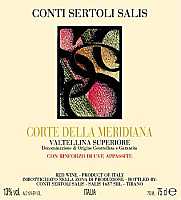
|
|
Valtellina Superiore Corte della Meridiana 2003 |
|
| Conti Sertoli Salis (Lombardy, Italy) | |
| Grapes: Nebbiolo (Chiavennasca) | |
| Price: € 19.00 | Score: |
| This wine shows a brilliant ruby red color and nuances of brick red, moderate transparency. The nose denotes intense, clean, pleasing and refined aromas which start with hints of cherry, plum and violet followed by aromas of blueberry, rose, raspberry, vanilla, tobacco, licorice, cinnamon, cocoa and menthol. The mouth has good correspondence to the nose, a tannic attack and pleasing crispness, however balanced by alcohol, full body, intense flavors. The finish is persistent with flavors of cherry, plum and blueberry. Valtellina Superiore Corte della Meridiana is produced with the “rinforzo” method and ages for 18 months in cask followed by at least 6 months of aging in bottle. | |
| Food Match: Game, Roasted meat, Braised and stewed meat, Hard cheese | |
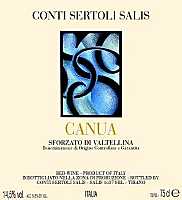
|
|
Sforzato di Valtellina Canua 2002 |
|
| Conti Sertoli Salis (Lombardy, Italy) | |
| Grapes: Nebbiolo (Chiavennasca) | |
| Price: € 32.00 | Score: |
| Sforzato di Valtellina Canua shows a brilliant ruby red color and nuances of brick red, moderate transparency. The nose reveals intense, clean, pleasing, refined and elegant aromas that start with hints of cherry, dried violet and prune followed by aromas of vanilla, dried rose, tobacco, leather, star anise, cinnamon, cocoa, pink pepper, licorice, mace and menthol. The mouth has good correspondence to the nose, a tannic attack and pleasing crispness, however balanced by alcohol, full body, intense flavors, agreeable roundness. The finish is very persistent with long flavors of cherry and prune. A well made wine. Sforzato di Valtellina Canua ages for 2 years in barrique followed by at least 6 months of aging in bottle. | |
| Food Match: Game, Braised and stewed meat, Roasted meat, Hard cheese | |
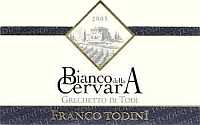
|
|
Colli Martani Grechetto di Todi Bianco della Cervara 2005 |
|
| Franco Todini (Umbria, Italy) | |
| Grapes: Grechetto | |
| Price: € 6.00 | Score: |
| The wine shows a pale straw yellow color and nuances of greenish yellow, very transparent. The nose denotes intense, clean, pleasing and refined aromas which start with hints of peach, pear and hawthorn followed by aromas of pineapple, chamomile, hazelnut, apple, broom and plum. The mouth has good correspondence to the nose, a crisp attack and however balanced by alcohol, good body, intense flavors, agreeable. The finish is persistent with flavors of peach, pear and pineapple. This wine ages in steel tanks. | |
| Food Match: Fried fish, Pasta and risotto with fish, Broiled fish and crustaceans | |
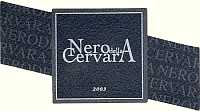
|
|
Nero della Cervara 2003 |
|
| Franco Todini (Umbria, Italy) | |
| Grapes: Merlot (50%), Cabernet Sauvignon (50%) | |
| Price: € 30.00 | Score: |
| Nero della Cervara shows an intense ruby red color and nuances of ruby red, little transparency. The nose denotes intense, clean, pleasing, refined and elegant aromas which start with hints of plum, black cherry and black currant followed by aromas of blueberry, vanilla, tobacco, licorice, chocolate, black pepper, mace and eucalyptus. The mouth has good correspondence to the nose, a tannic attack and pleasing roundness, however balanced by alcohol, good body, intense flavors, agreeable. The finish is persistent with flavors of black cherry, plum and black currant. Nero della Cervara ages for 12 months in barrique. | |
| Food Match: Roasted meat, Stewed and braised meat, Hard cheese | |
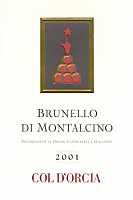
|
|
Brunello di Montalcino 2001 |
|
| Col d'Orcia (Tuscany, Italy) | |
| Grapes: Sangiovese | |
| Price: € 26.50 | Score: |
| This Brunello di Montalcino shows a brilliant ruby red color and nuances of garnet red, moderate transparency. The nose reveals intense, clean, pleasing, refined and elegant aromas that start with hints of plum, black cherry and blueberry followed by aromas of violet, vanilla, tobacco, leather, pink pepper, licorice, chocolate and menthol. The mouth has good correspondence to the nose, a tannic attack and pleasing crispness, however balanced by alcohol, full body, intense flavors, agreeable. The finish is persistent with flavors of plum and black cherry. A well made wine. This Brunello di Montalcino ages for 4 years in cask followed by 12 months of aging in bottle. | |
| Food Match: Game, Roasted meat, Braised and stewed meat, Hard cheese | |
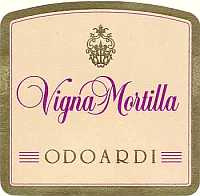
|
|
Savuto Superiore Vigna Mortilla 2001 |
|
| Odoardi (Calabria, Italy) | |
| Grapes: Gaglioppo (45%), Greco Nero (15%), Magliocco Canino (15%), Nerello Cappuccio, Sangiovese (25%) | |
| Price: € 18.00 | Score: |
| The wine shows an intense ruby red color and nuances of ruby red, little transparency. The nose denotes intense, clean, pleasing, refined and elegant aromas that start with hints of blackberry, plum and black cherry followed by aromas of blueberry, vanilla, violet, tobacco, licorice, chocolate, mace, pink pepper and menthol. The mouth has good correspondence to the nose, a tannic attack and however balanced by alcohol, full body, intense flavors, agreeable. The finish is persistent with flavors of blackberry, black cherry and plum. A well made wine. Savuto Superiore Vigna Mortilla ages for 14 months in barrique. | |
| Food Match: Game, Roasted meat, Stewed and braised meat, Hard cheese | |
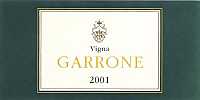
|
|
Scavigna Vigna Garrone 2001 |
|
| Odoardi (Calabria, Italy) | |
| Grapes: Gaglioppo (80%), Nerello Cappuccio (10%), Cabernet Franc (5%), Cabernet Sauvignon, Merlot (5%) | |
| Price: € 28.00 | Score: |
| Scavigna Vigna Garrone shows a deep ruby red color and nuances of ruby red, impenetrable to light. The nose reveals intense, clean, pleasing, refined and elegant aromas which start with hints of black cherry, blueberry and blackberry followed by aromas of plum, violet, vanilla, tobacco, black pepper, cocoa, licorice, clover, mace and menthol. The mouth has excellent correspondence to the nose, a tannic attack and however balanced by alcohol, full body, intense flavors, agreeable. The finish is very persistent with long flavors of black cherry, blueberry and blackberry. A well made wine. Scavigna Vigna Garrone ages for 18 months in barrique followed by 8 months of aging in bottle. | |
| Food Match: Game, Roasted meat, Braised and stewed meat, Hard cheese | |
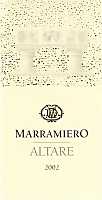
|
|
Trebbiano d'Abruzzo Altare 2002 |
|
| Marramiero (Abruzzo, Italy) | |
| Grapes: Trebbiano d'Abruzzo | |
| Price: € 11.50 | Score: |
| The wine shows an intense golden yellow color and nuances of golden yellow, very transparent. The nose reveals intense, clean, pleasing and refined aromas which start with hints of quince, plum and almond followed by aromas of citrus fruits, honey, hawthorn, vanilla and pear. The mouth has good correspondence to the nose, a crisp attack and pleasing roundness, however balanced by alcohol, good body, intense flavors. The finish is persistent with flavors of plum, quince and almond. Trebbiano d'Abruzzo Altare ages for 16-18 months in cask followed by 12 months of aging in bottle. | |
| Food Match: Stuffed pasta with mushrooms, Roasted white meat, Roasted fish | |

|
|
Montepulciano d'Abruzzo Inferi 2001 |
|
| Marramiero (Abruzzo, Italy) | |
| Grapes: Trebbiano d'Abruzzo | |
| Price: € 17.50 | Score: |
| The wine shows a deep ruby red color and nuances of garnet red, little transparency. The nose reveals intense, clean, pleasing, refined and elegant aromas which start with hints of blackberry, plum and black cherry followed by aromas of blueberry, vanilla, licorice, cocoa, cinnamon, tobacco, mace and black pepper. The mouth has good correspondence to the nose, a tannic attack and however balanced by alcohol, full body, intense flavors, agreeable. The finish is persistent with flavors of plum, blackberry and black cherry. A well made wine. Montepulciano d'Abruzzo Inferi ages for 24 months in steel tanks, 18 months in barrique and for 6 months in bottle. | |
| Food Match: Game, Roasted meat, Braised and stewed meat with mushrooms, Hard cheese | |
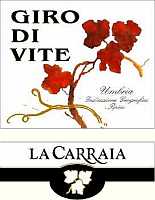
|
|
Giro di Vite 2004 |
|
| La Carraia (Umbria, Italy) | |
| Grapes: Montepulciano | |
| Price: € 14.00 | Score: |
| Giro di Vite shows a deep ruby red color and nuances of ruby red, little transparency. The nose denotes intense, clean, pleasing, refined and elegant aromas which start with hints of black cherry, plum and blueberry followed by aromas of violet, vanilla, tobacco, pomegranate, cinnamon, cocoa, carob, licorice and eucalyptus. The mouth has good correspondence to the nose, a tannic attack and however balanced by alcohol, good body, intense flavors. The finish is persistent with flavors of plum, black cherry and blueberry. A well made wine. Giro di Vite ages for 12 months in barrique followed by 6 months of aging in bottle. | |
| Food Match: Roasted meat, Braised and stewed meat, Hard cheese | |
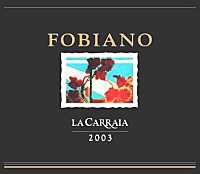
|
|
Fobiano 2004 |
|
| La Carraia (Umbria, Italy) | |
| Grapes: Merlot (70%), Cabernet Sauvignon (30%) | |
| Price: € 17.00 | Score: |
| The wine shows a deep ruby red color and nuances of purple red, little transparency. The nose denotes intense, clean, pleasing, refined and elegant aromas which start with hints of black cherry, black currant and plum followed by aromas of blueberry, vanilla, violet, tobacco, cocoa, pink pepper, mace and eucalyptus. The mouth has good correspondence to the nose, a tannic attack and however balanced by alcohol, good body, intense flavors, agreeable. The finish is persistent with flavors of black currant, plum and black cherry. A well made wine. Fobiano ages for 12 months in barrique followed by 6 months of aging in bottle. | |
| Food Match: Roasted meat, Braised and stewed meat, Hard cheese | |
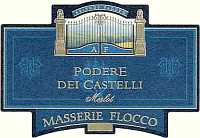
|
|
Podere dei Castelli Merlot 2005 |
|
| Masserie Flocco (Molise, Italy) | |
| Grapes: Merlot (95%) | |
| Price: € 7.00 | Score: |
| The wine shows a brilliant ruby red color and nuances of ruby red, moderate transparency. The nose has good personality with intense, clean, pleasing and refined aromas that start with hints of black cherry, raspberry and strawberry followed by aromas of blueberry, cyclamen, violet and plum. The mouth has good correspondence to the nose, a slightly tannic attack and however balanced by alcohol, good body, intense flavors, agreeable. The finish is persistent with flavors of black cherry, raspberry and strawberry. This wine ages in steel tanks. | |
| Food Match: Sauteed meat with mushrooms, Stuffed pasta, Broiled meat and barbecue | |

|
|
Molise Tintilia I Kuq 2004 |
|
| Masserie Flocco (Molise, Italy) | |
| Grapes: Tintilia | |
| Price: € 10.50 | Score: |
| This wine shows an intense ruby red color and nuances of garnet red, little transparency. The nose reveals good personality with intense, clean, pleasing and refined aromas which start with hints of cherry, plum and black currant followed by aromas of cyclamen, violet, pickle and black pepper. The mouth has good correspondence to the nose, a tannic attack and appreciable crispness, however balanced by alcohol, good body, intense flavors. The finish is persistent with flavors of cherry and plum. Molise Tintilia I Kuq ages in steel tanks. | |
| Food Match: Stuffed pasta, Sauteed meat with mushrooms, Broiled meat and barbecue | |
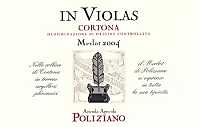
|
|
Cortona Merlot In Violas 2004 |
|
| Poliziano (Tuscany, Italy) | |
| Grapes: Merlot (85%), Cabernet Sauvignon (15%) | |
| Price: € 17.00 | Score: |
| This wine shows an intense ruby red color and nuances of ruby red, little transparency. The nose reveals intense, clean, pleasing, refined and elegant aromas that start with hints of black currant, plum and black cherry followed by aromas of blueberry, pink pepper, vanilla, tobacco, licorice, chocolate, graphite, mace and eucalyptus. The mouth has good correspondence to the nose, a tannic attack and pleasing roundness, however balanced by alcohol, good body, intense flavors. The finish is persistent with flavors of black currant, black cherry and plum. A well made wine. Cortona Merlot In Violas ages for 18 months in barrique followed by 6 months of aging in bottle. | |
| Food Match: Roasted meat, Braised and stewed meat, Hard cheese | |
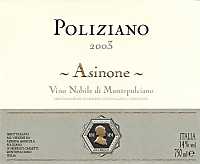
|
|
Vino Nobile di Montepulciano Asinone 2003 |
|
| Poliziano (Tuscany, Italy) | |
| Grapes: Prugnolo Gentile | |
| Price: € 31.00 | Score: |
| This Nobile di Montepulciano shows an intense ruby red color and nuances of ruby red, little transparency. The nose reveals intense, clean, pleasing, refined and elegant aromas that start with hints of plum, black cherry and blueberry followed by aromas of violet, black currant, tobacco, vanilla, pink pepper, graphite, cocoa, menthol and hints of rubber. The mouth has excellent correspondence to the nose, a tannic attack and however balanced by alcohol, full body, intense flavors, agreeable. The finish is very persistent with long flavors of black cherry, blueberry and plum. A well made wine. Vino Nobile di Montepulciano Asinone ages for 18 months in cask and in barrique followed by at least 8 months of aging in bottle. | |
| Food Match: Game, Roasted meat, Braised and stewed meat, Hard cheese | |
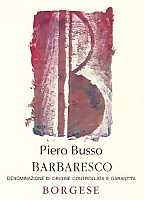
|
|
Barbaresco Vigna Borgese 2003 |
|
| Piero Busso (Piedmont, Italy) | |
| Grapes: Nebbiolo | |
| Price: € 23.50 | Score: |
| The wine shows a brilliant ruby red color and nuances of brick red, moderate transparency. The nose reveals intense, clean, pleasing, refined and elegant aromas which start with hints of cherry, plum and raspberry followed by aromas of violet, vanilla, tobacco, licorice, cinnamon, cocoa, mace and menthol. The mouth has good correspondence to the nose, a tannic attack and pleasing crispness, however balanced by alcohol, full body, intense flavors. The finish is persistent with flavors of cherry, plum and raspberry. Barbaresco Vigna Borgese ages for 24 months in cask followed by 6 months of aging in bottle. | |
| Food Match: Roasted meat, Game, Braised and stewed meat, Hard cheese | |

|
|
Barbera d'Alba S. Stefanetto 2004 |
|
| Piero Busso (Piedmont, Italy) | |
| Grapes: Barbera | |
| Price: € 15.00 | Score: |
| The wine shows a deep ruby red color and nuances of ruby red, little transparency. The nose reveals intense, clean, pleasing, refined and elegant aromas which start with hints of cherry, plum and black currant followed by aromas of blueberry, blackberry, violet, vanilla, tobacco, coffee, licorice, chocolate and menthol. The mouth has good correspondence to the nose, a tannic attack and pleasing roundness, however balanced by alcohol, good body, intense flavors. The finish is persistent with flavors of cherry, plum and black currant. Barbera d'Alba S. Stefanetto ages for 12 months in barrique followed by 12 months of aging in bottle. | |
| Food Match: Braised and stewed meat with mushrooms, Roasted meat, Hard cheese | |
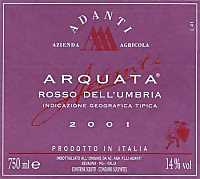
|
|
Arquata Rosso 2001 |
|
| Adanti (Umbria, Italy) | |
| Grapes: Cabernet Sauvignon, Cabernet Franc (40%), Merlot (40%), Barbera (20%) | |
| Price: € 16.00 | Score: |
| Arquata Rosso shows an intense ruby red color and nuances of ruby red, little transparency. The nose denotes intense, clean, pleasing, refined and elegant aromas which start with hints of black cherry, plum and black currant followed by aromas of blueberry, blackberry, licorice, tobacco, vanilla, violet, cocoa, cinnamon and eucalyptus. The mouth has good correspondence to the nose, a tannic attack and however balanced by alcohol, full body, intense flavors, agreeable. The finish is persistent with flavors of plum, black currant and black cherry. A well made wine. Arquata Rosso ages in cask for 24 months followed by 6 months of aging in bottle. | |
| Food Match: Game, Braised and stewed meat, Roasted meat, Hard cheese | |
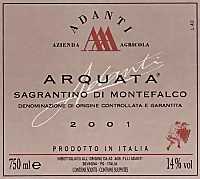
|
|
Sagrantino di Montefalco 2001 |
|
| Adanti (Umbria, Italy) | |
| Grapes: Sagrantino | |
| Price: € 21,00 | Score: |
| This Sagrantino di Montefalco shows an intense ruby red color and nuances of garnet red, little transparency. The nose reveals intense, clean, pleasing, refined and elegant aromas which start with hints of black cherry, blackberry and plum followed by aromas of blueberry, violet, vanilla, licorice, cocoa, cinnamon, leather, juniper, pink pepper, tobacco and menthol. The mouth has very good correspondence to the nose, a tannic attack and however balanced by alcohol, full body, intense flavors, agreeable. The finish is very persistent with long flavors of blackberry, black cherry and plum. A well made wine. This Sagrantino di Montefalco ages for 26 months in cask followed by 12 months of aging in bottle. | |
| Food Match: Game, Braised and stewed meat, Roasted meat, Hard cheese | |
Castel de PaolisIn Grottaferrata, near Rome, after a long period of research and experimentation, Castel de Paolis is now one of the most important wineries of Latium |
|
Italian enology is living in the last twenty years a moment of renewal and splendor. After a very long time characterized by productions based on quantity - in which quality was a factor found in few viticultural contexts only - in every region of Italy can today be found remarkable quality productions. Regions and wine areas which were once scarcely considered, have been capable of proving their great potentials, revaluating the unique expression of every territory, of their grapes and wines. Among these regions certainly is found Latium, that in recent times has been successful in radically change the image of its wines and their quality, once simply considered as “ordinary”, have today become real “outsiders”. The job done in Latium is exemplar in many aspects, from the revaluation of local grapes to the introduction of new varieties, from the drastic change in the production techniques to the way of communicating wine to the world.
Among the wineries which strongly contributed to the promotion of the image of wines from Latium there is Castel de Paolis, owned by the Santarelli family, which in few years has been capable to bring to the highest level the Frascati wine, one of the most famous wines of Castelli Romani. The winery takes its name from one of the most important fortresses for the control of Roman countrysides during Medieval times. Castel de Paolis fortress was built upon the ruins of a villa dated back to Roman times that, thanks to its strategic position, allowed the control of an ancient road connecting Rome to Castromoenium. In past times it was believed Castel de Paolis hill was the ancient site of Castromoenium, however recent studies have confirmed the ancient Roman colony corresponds to the present city of Marino. Also the lands in which today are found the vineyards of Castel de Paolis were crossed by a paved road connecting the Castrimense road to the Latina road. Castel de Paolis winery is located in the commune of Grottaferrata, few tens of kilometers away from Rome - in the Castelli Romani area and in the Denominazione d'Origine Controllata territory of Frascati - covers a total area of twelve hectares completely destined to the cultivation of vineyards. The winery is located in a hilly position at an altitude of 270 meters in soils of volcanic origin. The history of Castel de Paolis begins in 1985, when Giulio Santarelli, together with his wife Adriana Croce, rediscovers the passion of the art of making wine, a passion which will soon bring him to dedicate all of his time to the family winery. The fundamental event will take place in 1985, when Giulio Santarelli meets professor Attilio Scienza, of Milan University and at those times director of the prestigious Agricultural Institute of San Michele all'Adige. Professor Attilio Scienza, during a visit at Castel de Paolis, suggested Giulio Santarelli to resume in his vineyards the cultivation of the ancient autochthonous varieties which in past times were capable of making everywhere famous the wines of Castelli Romani, but unfortunately at those times were not as successful as they used to be.
That was the beginning of a long and precious research and experimentation activity, during which were uprooted the Malvasia di Candia and Trebbiano Toscano vineyards of Castel de Paolis. They then proceeded with the search of the old vines of the area: Malvasia Puntinata del Lazio, Bombino Bianco, Cacchione, Bellone, Passerina, Pecorino, Grechetto and Romanesca, at those times rare in the vineyards of Castelli Romani. When they finally found the varieties, it was planted an experimental vineyard which gave good results. They then decided to extend the varieties of grapes with which make their experimentation, by using the international varieties: Sauvignon Blanc, Chardonnay, Syrah, Cabernet Sauvignon, Viognier, Sémillon, Pink Muscat, Golden Muscat, Roussanne, Merlot and Petit Verdot. The experimental phase - which ended in 1992 - has also led to the creation of a winery equipped with the most advanced technologies and in which were exclusively vinified the grapes coming from the experimental vineyards under the technical supervision of winemaker Lorenzo Peira. At the end of the experimental phase, Castel de Paolis winery was ready to let the results of this fundamental research activity meet the world, and catching since the very first moments a high interest from consumers and wine lovers. Wines belonging to the Frascati DOC and produced by Castel de Paolis were so impressive as to believe they belonged to another appellation: the new history of Frascati and the wines of Castelli Roman was just begun. A result - which is still today one of the most interesting in Latium - obtained by joining tradition and innovation in the essential and fundamental role of experimentation, while proving that, given favorable conditions and right viticultural practices, it is possible to keep and improve the enological tradition of a territory. The cellar was supervised up to 2003 by winemaker Franco Bernabei, whereas today it is led by winemaker Carlo Corino. The vineyards of Castel de Paolis winery are cultivated according to the principles of organic agriculture, with a density of 5,500 plants per hectare and each vine providing a maximum of 1.5 kilograms of grapes. Wines are currently exported in the United States of America, Japan, Australia, United Kingdom, Germany, Denmark, Belgium, Austria, France and Switzerland. The production is based both on white and red wines, completed by the interesting sweet wines Rosathea, produced with Pink Muscat, Frascati Cannellino and Muffa Nobile, produced with Sémillon and Sauvignon Blanc grapes. The production of white wines is composed of Frascati Superiore DOC, Campovecchio Bianco, Vigna Adriana - one of the flagship wines of Castel de Paolis and produced with Malvasia Puntinata del Lazio, Viognier and Sauvignon Blanc - and Selve Vecchie, produced with Chardonnay and Sauvignon Blanc grapes. The production of red wines is composed by Campovecchio Rosso - produced with Syrah, Cesanese d'Affile, Montepulciano and Sangiovese grapes - and I Quattro Mori, produced with Syrah, Merlot, Cabernet Sauvignon and Petit Verdot grapes, aged for 18 months in barrique.
|
||||||||||||||||||||
|
Score legend Prices are to be considered as indicative. Prices may vary according to the country or the shop where wines are bought |

|
|
Campovecchio Bianco 2005 |
|
| Castel de Paolis (Latium, Italy) | |
| Grapes: Malvasia del Lazio, Bellone, Romanesca, Bonvino, Passerina, Grechetto, Trebbiano Giallo | |
| Price: € 7.00 | Score: |
| Campovecchio Bianco shows a pale straw yellow color and nuances of greenish yellow, very transparent. The nose denotes intense, clean, pleasing and refined aromas which start with hints of pear, apple and hawthorn followed by aromas of broom, pineapple, peach and plum. The mouth has good correspondence to the nose, a crisp attack and however balanced by alcohol, good body, intense flavors, agreeable. The finish is persistent with flavors of apple, pear and pineapple. Campovecchio Bianco ages in steel tanks. | |
| Food Match: Fried fish, Pasta and risotto with vegetables and fish, Sauteed fish | |

|
|
Frascati Superiore 2005 |
|
| Castel de Paolis (Latium, Italy) | |
| Grapes: Malvasia di Candia, Malvasia del Lazio, Trebbiano Toscano, Bonvino, Pecorino, Cacchione, Grechetto, Passerina | |
| Price: € 10.00 | Score: |
| This Frascati Superiore shows a pale golden yellow color and nuances of straw yellow, very transparent. The nose reveals intense, clean, pleasing and refined aromas which start with hints of plum, apple and pear followed by aromas of hawthorn, pineapple, almond and acacia. The mouth has good correspondence to the nose, a crisp attack and however balanced by alcohol, good body, intense flavors. The finish is persistent with flavors of apple, pear and pineapple. This Frascati Superiore ages in steel tanks. | |
| Food Match: Pasta with meat and fish, Roasted white meat, Roasted fish | |

|
|
Campovecchio Rosso 2003 |
|
| Castel de Paolis (Latium, Italy) | |
| Grapes: Syrah (50%), Cesanese d'Affile (20%), Montepulciano (20%), Sangiovese (10%) | |
| Price: € 11.00 | Score: |
| This wine shows an intense ruby red color and nuances of garnet red, moderate transparency. The nose denotes intense, clean, pleasing and refined aromas that start with hints of black cherry, plum and blueberry followed by aromas of black currant, violet, vanilla, tobacco and pink pepper. The mouth has good correspondence to the nose, a slightly tannic attack and however balanced by alcohol, good body, intense flavors. The finish is persistent with flavors of plum and black cherry. The Syrah used for Campovecchio Rosso ages for 18 months in barrique, whereas the other grapes ages in steel tanks. | |
| Food Match: Stuffed pasta, Stewed meat, Broiled meat and barbecue | |

|
|
Vigna Adriana 2005 |
|
| Castel de Paolis (Latium, Italy) | |
| Grapes: Malvasia Puntinata, Viognier, Sauvignon Blanc | |
| Price: € 16.00 | Score: |
| Vigna Adriana shows a pale straw yellow color and nuances of greenish yellow, very transparent. The nose denotes intense, clean, pleasing and refined aromas which start with hints of pear, apple and peach followed by aromas of pineapple, hawthorn, broom, gooseberry, plum and mineral. The mouth has good correspondence to the nose, a crisp attack and however balanced by alcohol, good body, intense flavors, agreeable. The finish is persistent with flavors of pear, apple and peach. Vigna Adriana ages in steel tanks. | |
| Food Match: Pasta with mushrooms and fish, Fried fish, Stewed fish, Sauteed white meat | |

|
|
I Quattro Mori 2003 |
|
| Castel de Paolis (Latium, Italy) | |
| Grapes: Syrah (65%), Merlot (20%), Cabernet Sauvignon (10%), Petit Verdot (5%) | |
| Price: € 27.00 | Score: |
| This wine shows an intense ruby red color and nuances of ruby red, little transparency. The nose denotes intense, clean, pleasing and refined aromas that start with hints of prune and black cherry followed by aromas of black currant, blueberry, vanilla, tamarind, tobacco, cinnamon, chocolate, mace and eucalyptus. The mouth has good correspondence to the nose, a slightly tannic attack and pleasing roundness, however balanced by alcohol, good body, intense flavors. The finish is persistent with flavors of prune and black cherry. I Quattro Mori ages for 18 months in barrique. | |
| Food Match: Stuffed pasta with mushrooms, Braised and stewed meat, Roasted meat | |

|
|
Muffa Nobile 2005 |
|
| Castel de Paolis (Latium, Italy) | |
| Grapes: Sémillon (80%), Sauvignon Blanc (20%) | |
| Price: € 20.00 - 50cl | Score: |
| The wine shows an intense amber yellow color and nuances of amber yellow, transparent. The nose denotes intense, clean, pleasing and refined aromas which start with hints of dried apricot, date and raisin followed by aromas of peach jam, honey, quince jam, dried fig and almond. The mouth has good correspondence to the nose, a sweet and round attack, however balanced by alcohol, good body, intense flavors. The finish is persistent with flavors of raisin, dried apricot and honey. Muffa Nobile is produced with grapes completely affected by Botrytis Cinerea. | |
| Food Match: Hard and piquant cheese, Desserts | |
| Castel de Paolis - Via Val de Paolis, Grottaferrata, Roma (Italy) - Tel. +39 6 9413648 Fax: +39 6 94316026 - Winemaker: Carlo Corino - Established: 1985 - Production: 90.000 bottles - E-Mail: info@casteldepaolis.it - WEB: www.casteldepaolis.it |
Cellar Journal |
|
This section is reserved to wine producers who want to publish news and information about their business, to announce new products or just for communicating to customers information and promotions about their products and activity. Send news to be published to our e-mail address.
|
News |
|
In this section are published news and information about events concerning the world of wine and food. Whoever is interested in publishing this kind of information can send us a mail to our address.
|
Making Wine: the MustThe production of the must represents the first stage of processing in the cellar, an operation which begins with the selection and crushing of the bunches of grapes |
|
The stage following harvesting consists in the production of the must, that is the crushing of the berries of grapes in order to get the juice that will be subsequently fermented into wine. Despite this operation could seem easy in its execution - the crushing of grapes is in fact an easy procedure - it must indeed be done in the best possible way in order not to compromise the quality of the grape and of its juice, by using - when needed - proper corrections. Of course, corrections done in the must depends on the quality of grapes: sound and quality grapes give a sound and quality must which does not require any correction. However, also in quality musts - and according to the type of wine to be made - it will be necessary to adopt proper precautions in order to avoid and prevent any alteration produced, for example, by the contact with oxygen. The goal of anyone who wants to make a good wine is always and however the same: to have sound and quality grapes in order to avoid as much as possible any kind of correction, both on the must and on the wine.
According to a technical point of view, the must is the product obtained from fresh grapes - with or without stems and skins - by means of the mechanical procedures of crushing, draining and pressing. If we consider the must as the result of the crushing of grapes without using any other process, it is made of 80-85% pulp, 10-15% skins, 5% pips. During crushing - that is the operation consisting in the squeezing of berries - it is also generally done the so called destemming, that is the separation of stems in order not to excessively enrich the must with harsh tannins: an operation considered practically indispensable for the musts destined to the production of white wines. The must is the liquid fraction of the crushing of grapes - the juice - made of 70-80% water, 10-30% sugars (mainly fructose and glucose) as well as mineral and nitrogenous substances (inorganic and proteinic), polyphenols (tannins and coloring substances) and organic acids. The pomace is the solid fraction of the crushing of grapes and made of fibrous parts of the pulp, pips and skins. The analysis done in the must also detects the presence of yeasts, both because they are naturally found in the air, as well as - and in particular - they are found in the bloom, the opaque and whitish layer covering the skin of grape berries. Acid substances - even though they are not very perceptible at the taste because of the contrast action of sugar - generally have pH values from 2.7 to 3.5, indispensable for a regular fermentation process. In the must are also found vitamins of the groups A, B and C, mineral substances (potassium, calcium, magnesium, sodium, phosphates, chlorides, iron and copper) useful for a regular fermentation process and for the stability and limpidity of wine. Of particular importance is the presence of nitrogenous substances, indispensable to the development of yeasts responsible for alcoholic fermentation. These substances, at the end of fermentation, are transformed into aromatic components, some of them being very important in the overall aroma of wine. Despite their important role, the excessive presence of nitrogenous substances in the must can be cause of clouding in the wine as well as compromising its stability.
|
||||||||
|
Despite the crushing of grapes - the operation allowing the production of the must - is simple in its form, indeed it is important to use proper tools. In specialized shops are usually available many types of mechanical crushers allowing the crushing of large quantities of grapes and in pretty short times. The rapidity with which the grape is crushed is in fact of fundamental importance, as from the moment of harvesting to the time of the production of the must, it must pass the shortest possible time. One of the main problems in home wine making is represented by the procedure of separating the stems from the grape, an operation which is considered indispensable for the production of white wines. The crushing of grapes must be in fact preceded by destemming, that is the separation of the stems - the woody central part of the bunch to which are attached the berries - in order not to give the must excessive quantities of harsh tannins. On this regard, it should be remembered that in some cases, in particular when the grapes are poor in tannins, destemming can be avoided, however it is always suggested in the production of white wines in order to ensure a better finesse and elegance. This operation can be done by using a special machine - called destemmer - however it is more convenient and practical the use of a crusher-destemmer, that is a machine which besides separating the berries from the stem, crushes the grape as well. There are many types of crusher-destemmer available and not all are the same. A good crusher-destemmer machine, besides allowing the separation of the stems, will crush the grapes in a pretty delicate way, without excessive force and in order to not excessively tear skins while avoiding the breaking of pips. The work done by a good crusher-destemmer machine is easy to recognize: skins are intact and show only one side splitting and pips are perfectly intact. The breaking of pips must be avoided in particular in the production of white wines, as they give excessive quantities of tannins to the must. Intact skins will also facilitate the operation of the draining of must, that is the separation of the solid parts from the liquid part. According to the type of wine to be made, the must must be processed properly. In case of white wine, it will done the draining, that is the immediate separation of the skins and pips in order to limit the extraction of polyphenols. In case the must is destined to the production of red wine, skins are then allowed to macerate for all the fermentation process, or until it is not obtained the desired color or quantity of tannins. Soon after crushing, because of the contact with the air and of the presence of the yeasts naturally found in the skins, the must begins to oxidize and to ferment. Oxidation must be avoided in any case - as well as in the wine - whereas in the case of the production of white wine, it is recommended to delay the fermentation process in order to allow a proper sedimentation of the solid parts present in the must. In the production of white wine is in fact recommended the use of limpid must with no solid substance - made by the residuals of the pulp and skins - in order to get a more limpid and stable wine. Sulfur dioxide is very useful and fundamental in wine making soon after the crushing of grapes because, thanks to its effects, avoids detrimental oxidations, do a proper selection of yeasts and temporarily blocks their action. These two qualities will be indispensable for musts destined to the production of white wine, as they block the action of yeasts and provide a bland clarifying action, allow the sedimentation of the solid parts present in the must while delaying the fermentation. Despite sulfur dioxide has unwanted effects in the human body, the quantities typically used in enology can be considered relatively safe, however it is always and however recommended to use the least indispensable quantity possible. In home wine making, the most simple and reliable addition of sulfur dioxide is represented by potassium metabisulfite, simple to weigh and to add. On the contrary, it is not recommended the use of sulfur tablets to be burnt inside containers, as this method does not allow the correct measure of the quantity of sulfur dioxide added to the must or wine. When using potassium metabisulfite, it is good to remember it contains about 55% of sulfur dioxide, therefore one gram of potassium metabisulfite produces 550 mg of sulfur dioxide. Concerning the must, the quantities of potassium metabisulfite to be added can range from 5 to 30 grams per hectoliter, variable quantities according to the quality and soundness of grapes. In case of sound grapes and with no faults, it will be enough to add from 5 to 10 grams of potassium metabisulfite per hectoliter, whereas in case of grapes affected by mold, or even worse, in case they are rotten, it will be used from 20 to 30 grams per hectoliter. In normal conditions, the use of 10-15 grams per hectoliter can be considered correct in order to ensure a good fermentation. It is however good to remember the higher the quantity of sulfur dioxide used in the must, the slower the beginning of the alcoholic fermentation. Moreover, excessive quantities of potassium metabisulfite (50-60 grams per hectoliter or more) completely inhibit the fermentation of the must as in this way are eliminated all the microorganisms, including yeasts. The adding of sulfur dioxide, either in the form of potassium metabisulfite or other methods, must be done according to the type of the must. As the sulfur dioxide has solvent effects in some components found in the skin of the grape berries - in particular coloring substances and polyphenols - it is not suggested the adding, practiced by many, directly in white grapes as this would cause a not very desirable deep yellow color in the must. In case of must produced with white grapes, it is always recommended to add sulfur dioxide after the phase of draining, that is after having removed the skins from the must. In any case, no matter the type of wine to be produced - either white or red - it is recommended to add sulfur dioxide directly to the must while homogeneously stirring the mass. The contact with skins is indispensable in must obtained from red grapes as it will be the skins to give color to the wine, whereas in case of white wine, they will be separated soon after crushing. The drained part can be then pressed and added to the must, or it can also be used for the production of less valuable wines.
|
||||
|
Despite we already analyzed the grapes in order to determine the right time of harvesting, before allowing the must to begin the stage of the alcoholic fermentation, it is recommended to do specific analyses in order to know its characteristics and - when needed - to do proper corrections. In home wine making it can be considered enough - as well as essential - the analysis of the quantity of sugar contained in the must, however it is important to analyze the quantity of acids as well. The analysis of the sugar contained in the must can be done by using a Babo densimeter or a refractometer, which gives the advantage of providing a more reliable result. In order to know the approximate alcohol by volume of the wine according to the quantity of sugar measured with the Babo densimeter or refractometer, readers are invited to read past articles about this subject. The analysis of acidity is more complex, in particular when done in the home wine making. In a glass container - preferably a Becher glass - are poured 7.5 milliliters of must to which are added 40 milliliters of distilled water and few drops of bromothymol blue. It is then added - slowly and while stirring continuously - sodium hydrate (NaOH) 0.1 N until the solution does not get a blue color, signaling all the acids found in the must have been neutralized (in red must will be noticed an evident clouding instead). The quantity of NaOH 0.1 N added, expressed in milliliters, will correspond to the total acidity of the must expressed in grams of tartaric acid per liter. The same method can also be used for determining the acidity of a wine. The correct quantity of acid in a must depends on the type of wine to be made. In case the must lacks of sugar or acidity, it is recommended to properly correct it. The increasing of the quantity of sugar in the must can be done either by adding concentrated must or common sugar, while remembering the latter method is forbidden in Italy for wines to be commercialized, whereas it is allowed in wines destined for personal consumption, such as the ones of home wine making. Each 1.7 kilograms of sugar added per hectoliter gives the increasing of the alcohol by volume of about 1%. The sugar must be diluted in few liters of must and then added to the mass in fermentation. The increasing of acidity in the must can be done by adding tartaric acid, usually available in enology shops. As tartaric acid tends to combine with some salts found in the must and in wine, each 1.3-1.5 grams of tartaric acid added per liter corresponds to the increasing of one gram per liter of acidity. Deacidification of the must is not recommended - saved the cases in which it is very high - as during alcoholic and malolactic fermentations, almost half of the original acidity is lost; therefore at the end of the production wine has probably reached the right acidity.
|
SugarSugar is the substance which allowed coffee and chocolate to become those delicious beverages today appreciated all over the world by millions of people |
|
In nature exist many substances with a sweet flavor, an organoleptic quality depending on the presence of one or more components commonly classified as “sugar”. Sugar, or better to say sugars, are found in nature not only in foods of vegetal origin but also in the ones of animal origin, and belong to the family of carbohydrates. Carbohydrates (or carbon hydrate) are made of, like the name suggests, by carbon, hydrogen and oxygen. Carbohydrates are divided in: monosaccharides, glucose and fructose; disaccharides, saccharose, lactose and maltose; polysaccharides, starch, cellulose, dextrin and glycogen. Sugars are not all the same, they differ from the level of solubility in water, melting point and, probably being the most interesting quality, the level of sweetness. In case we would assign saccharose the sweetness level of 100, lactose would have a level of 16, maltose 32, glucose 74 and fructose 173. Sugar, which chemical formula is C12H22O11, is mainly used for nutritional purposes, it in fact makes an easily assimilable food and very caloric: 4 calories per gram. The term sugar comes from Sanskrit sarkara, which then became sakcharon in Greece and finally saccharum for Romans.
|
|
The first information about sugar come from Polynesia, China and India, around 510 BC and it is referred to the sugarcane. The Persians at the times of Darius are said to have found cultivations of a vegetable from which was extracted a very sweet liquid, which was then transformed in crystals in order to be kept for a long time. Persians brought with them the sugarcane and they spread its cultivation all over the Middle East. Alexander the Great mentions it, in the 325 BC, by telling that in eastern countries was produced a liquid as sweet as honey however obtained without the use of any bee. Genovese and Venetians also contributed to the spreading, in the tenth century, by importing modest quantities of sugar at those times known as “Arab salt”.
Frederick of Swabia introduced the cultivation of sugarcane in Sicily. Sugar will however remain for many years a rare and precious good, sold at very high prices and only the noble people could use it as a sweetener, whereas ordinary people could afford the use of honey only. The discovery of America brought sugarcane in the New World, in particular Cuba, Mexico, Antilles and Brazil, which are still today among the main producers of the world. American sugar was cheaper and of higher quality as to overcome Arab and Sicilian cultivations. It was the beginning of a flourishing trade between America and Europe, so flourishing which caused prices to fall. This allowed many people to buy this delicacy therefore contributing to the born of pastry cooking art in Europe, together with cocoa, coffee and chocolate. In 1747, German chemist Andreas Sigismund Marggraf, by using some observations done by French agronomist Olivier de Serres, was successful in extracting saccharose from boiled beet juice. Some years later, in 1802, his student Franz Achard began the industrial production of sugar. The new discovery had a strong impact, and in 1806 cane sugar was replaced by beet sugar. This change was also favored by the increasing contrasts between France and England, which ended with the block of importations, including sugar, from England to Europe. From this moment on, the production and consumption of sugar did not face any stop or crisis.
|
||||||||
|
With the term sugar are identified a group of substances, all having a sweet taste, which are instead defined, according to type, with specific names. The most common type of sugar which we all have in our kitchen, is saccharose. It is mainly obtained by sugar beets or by sugarcane, however it is also possible to extract saccharose from maple, palm juice and sweet sorghum. Saccharose is found in many foods, such as pineapple, strawberries, carrots and beets. Saccharose completely melts in a quantity of water corresponding to one third of its weight. When heated without water, it melts at a temperature of 160° C and get caramelized at 180° C, when heated at higher temperatures it becomes similar to tar. Glucose is also known as dextrose. It is found in considerable quantities in grapes and makes hard clots in raisins. It makes, together with fructose, 30% of honey. It is usually commercialized in chips or in form of syrup, it is obtained by cooking starch, saccharose and chloride acid, subsequently neutralized with chalk which is then properly depurated. Liquid glucose is made of water (18%), glucose (35%) and dextrin (47%). Liquid glucose is used in pastry cooking and it is very useful in the preparation of home made desserts, or to sweeten jams and candied fruits. It was once considered as a lesser product than saccharose, today it is used as a quick source of energy. To the taste it is less sweet than saccharose, a characteristic which should be remembered in case it is used as a substitute of saccharose. Fructose, just like glucose, is found in honey and in ripe fruit, its use in cooking is pretty limited. Fructose is sweeter than glucose and it easily melts in water. Maltose, like the name would suggest, is obtained by the preparation of malt, when the “diastase” enzyme processes starch. Maltose is found in huge quantities in the extract of malt and it is very important for the preparation of bread and beer, as it is an excellent ally of yeasts, it is very soluble in water and it is hygroscopic. This latter one probably is the most important characteristic, together with its particular ease of use from yeast, for the making of bread. For this reason the bread prepared with malt extract can be kept for a longer time, thanks to the capacity of maltose to absorb and keep water. Lactose is the sugar contained in milk, it is less sweet than other types of sugars. It is obtained by the residual milk from the processing of butter. As it is a byproduct of the processing of milk, its characteristics are interesting in the production of cheese and derivatives. Lactose can be found in shops and its most typical use is represented by pastry cooking.
|
||||
|
Sugarcane (Saccharum officinarum) is a tropical plant belonging to the family of Poaceae, it is a plant similar to bamboo, with a very sweet marrow, juicy and rich in saccharose. In its countries of origin, sugarcane is cut in pieces about 10 centimeters long and chewed in order to extract its sweet juice, however not all the varieties can be used for this purpose. In order to make the taste of sugar more delicious and less monotonous, they invented some simple and quick recipes. The most common of them consists in blending the marrow of the cane, add lime juice and some spices, therefore obtaining a delicious beverage. Sugarcane is still today one of the main sources of sugar. The origins of sugarcane are from Asia: Chinese used it since 1000 BC. In 327 BC, when it was imported in Europe, it was already known in India. In 641 AD it was introduced in Egypt and a century later in Spain. Portuguese introduced it in Madera and Christophorus Columbus introduced it in America. Today sugarcane is cultivated all over the world, in the areas where the climate allows it. When we think about sugar, we usually think about a substance which is easy to find and sold at a cheap price. However, in past times it was not like that: white or refined sugar, the way we know it today, it is a relatively recent product. By analyzing ancient documents and recipes, it can be evinced sugar was used since Medieval times and it was an expensive and rare product: it was sold in pharmacies only. At those times the most common sweetener was honey. Sugar will become widely available and at a reasonable price at the beginning of the nineteenth century. In some areas of the world, in tropical areas, it is still today possible to see the traditional preparation of sugar: the cane is cut at the base and broken by using a grindstone made of two large wheels moved by oxes, the liquid is then collected in pots and allowed to boil over a fire, fed by the residual of the cane processing. When the liquid of canes boils, it is then added some lime juice. At this point the proteins of the liquid coagulates and the resulting foam is used for clarifying the mixture. At the end of the preparation it is obtained a thick and brown syrup. As the liquid cools down, the sugar begins to crystallize and when it has completely cooled down, it is formed a large block of raw cane sugar, called “muscorado”. In India it is used another type of raw sugar, more raw then the one described above, known with the name gur, and it is used in Indian cooking for the preparation of desserts and curry cooking. This type of sugar is usually found in shops specialized in Indian spices, and it should be remembered it is not used as a substitute of sugar. Today white sugar is obtained by chemically separating crystals from molasses, therefore obtaining a very refined product but with no aromas. The refining processes for sugar are believed to be invented in Arab countries. Refined sugar was allowed to cool down is moulds of conical shape, which gave origin to the term “sugar loaf”, subsequently broken, or better to say, crumbled in pieces before being used. Still today, sugar loaf is the sugar used in Persia in traditional tea houses. Whereas white refined sugar has little aromas, raw sugars keep part of the aromas of molasses. Today are available many types of raw sugar, however it should be remembered some add color to white sugar in order to make it look like raw sugar. This little trick can be easily revealed by putting the sugar in water: raw sugar does not become white. In cooking are also used other types of sugar which can contain as much as 50% of saccharose, as well as other sugars which do not crystallize, flavors and water. Cane molasses has a characteristic taste, it is used for the preparation of rum and it is very used in American cooking.
|
|
Sugarcane is cultivated in warm climate areas only, therefore in Europe were necessary specific studies and researches in order to find a local plant from which could be possible the extraction of sugar. In France they began researching from carrots, however, after many attempts, from the half of nineteenth century, beet became the most important source of sugar and therefore widely cultivated. The procedure of sugar extraction from beets is not different from the one used for sugarcane. Beets are gathered in wintertime, when the roots are ripe. Beets are then washed and mashed in order to get a mush and subsequently heated in water allowing the sugar to melt. The mixture is then treated with lime juice and carbon dioxide, favoring the precipitation of impurities. The liquid which is obtained is evaporated therefore obtaining at the end of the process sugar crystals. The product which is obtained is pure saccharose, indistinguishable from the saccharose obtained from sugarcane. Beet's molasses and raw sugar are not used because they have a bad taste, although molasses is used by industries.
|
|
Sugar maple is a characteristic tree of Eastern North America. Since the end of 1600s, explorers noticed native Indians produced a sweet syrup from the lymph of these plants. The first settlers developed and improved the production system, by boiling the lymph until getting a thick syrup, it was then poured in moulds immersed in snow in order to crystallize the molasses. Today the system has evolved and the lymph is extracted by cutting the bark of the trees and allowed to flow in a small pipe. The juice is then gathered and evaporated, after having been concentrated, allowing the extraction of sugar. Outside America it is the maple syrup to be mainly known, with its unmistakable aroma, it is used in America since ancient times in many recipes, for breakfast with waffles, pancakes and many other baked products. Palm sugar is obtained by many species of palms, by cutting the trunk or other parts and gathering the juice in containers. The warm climate makes the sweet liquid to quickly ferment: for this reason containers must be processed every day, in order to prevent the syrup, because of an excessive fermentation, to get transformed into “palm wine”. Palm sugar is prepared by artisans, with a processing similar to the one traditionally used for sugarcane. The appearance of this sugar has a dark color and a very strong taste. Palm sugar is usually available in shops specialized in Oriental foods and items, it is known with its Indian name jaggery. The lymph of palms does not contain saccharose, but other types of sugars, for this reason refining is not either convenient or efficient, therefore palm sugar usually has a pretty viscous consistency. Sweet sorghum is a large tropical herb, cultivated for nutritional purposes and it was one of the first plants to be cultivated by human beings. Sweet sorghum is not suited to the production of sugar, however from its juice can be obtained a sweet syrup. The consumption of refined sugar has raised in the course of the centuries and today every person consumes as much as 2 kilograms per year. The excessive consumption of sugar is considered responsible for some diseases, including cavities, diabetes and obesity.
|
AquavitaeReview of Grappa, Distillates and Brandy |
|
|
| Distillates are rated according to DiWineTaste's evaluation method. Please see score legend in the "Wines of the Month" section. |
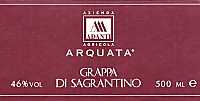
|
|
Grappa di Sagrantino |
|
| Adanti (Umbria, Italy) | |
| (Distiller: Distilleria Aquileia) | |
| Raw matter: Pomace of Sagrantino | |
| Price: € 20.00 - 50cl | Score: |
| The grappa is colorless, limpid and crystalline. The nose reveals intense, clean and pleasing aromas of blackberry, black cherry, plum, hazelnut and licorice with almost imperceptible alcohol pungency. In the mouth has intense flavors with evident alcohol pungency which tends to dissolve rapidly, good correspondence to the nose, good smoothness, balanced sweetness. The finish is persistent with flavors of blackberry, black cherry, and licorice. This grappa is produced with discontinuous steam operated alembic still. Alcohol 46%. | |
Wine Parade |
|
|
| The best 15 wines according to DiWineTaste's readers. To express your best three wines send us an E-mail or fill in the form available at our WEB site. |
| Rank | Wine, Producer | |
|---|---|---|
| 1 |
| Wine Obsession 2001, Vignamaggio (Italy) |
| 2 |
| Chianti Classico Riserva Novecento 2000, Dievole (Italy) |
| 3 |
| Amarone della Valpolicella Classico 2000, Zenato (Italy) |
| 4 |
| Nero al Tondo 2001, Ruffino (Italy) |
| 5 |
| Brunello di Montalcino 1999, Castello Banfi (Italy) |
| 6 |
| Chianti Classico Riserva Novecento 2000, Dievole (Italy) |
| 7 |
| Don Antonio 2003, Morgante (Italy) |
| 8 |
| Notarpanaro 1999, Taurino (Italy) |
| 9 |
| Amarone della Valpolicella Classico Costasera 2001, Masi (Italy) |
| 10 |
| Sagrantino di Montefalco Collepiano 2003, Arnaldo Caprai (Italy) |
| 11 |
| Colli Orientali del Friuli Rosazzo Bianco Terre Alte 2002, Livio Felluga (Italy) |
| 12 |
| Soave Classico Monte Alto 2004, Ca' Rugate (Italy) |
| 13 |
| Sagrantino di Montefalco 2003, Antonelli (Italy) |
| 14 |
| Sforzato di Valtellina Canua 2001, Conti Sertoli Salis (Italy) |
| 15 |
| Trento Talento Brut Riserva Methius 1998, Dorigati (Italy) |
| |||||||
Privacy Policy | |||||||


| Copyright © 2002-2024 Antonello Biancalana, DiWineTaste - All rights reserved |
| All rights reserved under international copyright conventions. No part of this publication and of this WEB site may be
reproduced or utilized in any form or by any means, electronic or mechanical, without permission in writing from DiWineTaste. |